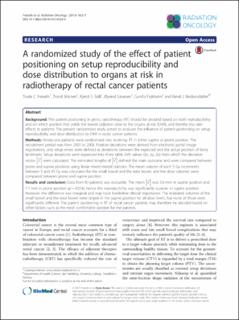| dc.contributor.author | Frøseth, Trude Camilla Salvesen | |
| dc.contributor.author | Strickert, Trond | |
| dc.contributor.author | Solli, Kjersti Sund | |
| dc.contributor.author | Salvesen, Øyvind | |
| dc.contributor.author | Frykholm, Gunilla | |
| dc.contributor.author | Reidunsdatter, Randi Johansen | |
| dc.date.accessioned | 2020-06-15T07:22:07Z | |
| dc.date.available | 2020-06-15T07:22:07Z | |
| dc.date.created | 2015-12-22T12:26:49Z | |
| dc.date.issued | 2015 | |
| dc.identifier.issn | 1748-717X | |
| dc.identifier.uri | https://hdl.handle.net/11250/2657958 | |
| dc.description.abstract | Background:The patient positioning in pelvic radiotherapy (RT) should be decided based on both reproducibilityand on which position that yields the lowest radiation dose to the organs at risk (OAR), and thereby less sideeffects to patients. The present randomized study aimed to evaluate the influence of patient positioning on setupreproducibility and dose distribution to OAR in rectal cancer patients.Methods:Ninety-one patients were randomized into receiving RT in either supine or prone position. Therecruitment period was from 2005 to 2008. Position deviations were derived from electronic portal imageregistrations, and setup errors were defined as deviations between the expected and the actual position of bonylandmarks. Setup deviations were expressed into three table shift values (Δx,Δy,Δz) from which the deviationvectorv→were calculated. The estimated lengths ofv→defined the main outcome and were compared betweenprone and supine positions using linear mixed model statistics. The mean volume of each 5 Gy incrementsbetween 5 and 45 Gy was calculated for the small bowel and the total bowel, and the dose volumes werecompared between prone and supine position.Results and conclusion:Data from 83 patients was evaluable. The meanv→was 5.8 mm in supine position and7.1 mm in prone position (p= 0.024), hence the reproducibility was significantly superior in supine position.However, the difference was marginal and may have borderline clinical importance. The irradiated volumes of thesmall bowel and the total bowel were largest in the supine position for all dose levels, but none of those weresignificantly different. The patient positioning in RT of rectal cancer patients may therefore be decided based onother factors such as the most comfortable position for the patients. | en_US |
| dc.language.iso | eng | en_US |
| dc.publisher | BMC | en_US |
| dc.rights | Navngivelse 4.0 Internasjonal | * |
| dc.rights.uri | http://creativecommons.org/licenses/by/4.0/deed.no | * |
| dc.title | A randomized study of the effect of patient positioning on setup reproducibility and dose distribution to organs at risk in radiotherapy of rectal cancer patients | en_US |
| dc.type | Peer reviewed | en_US |
| dc.type | Journal article | en_US |
| dc.description.version | publishedVersion | en_US |
| dc.source.volume | 10 | en_US |
| dc.source.journal | Radiation Oncology | en_US |
| dc.source.issue | 1 | en_US |
| dc.identifier.doi | 10.1186/s13014-015-0524-3 | |
| dc.identifier.cristin | 1303768 | |
| dc.description.localcode | © 2015 Frøseth et al.Open AccessThis article is distributed under the terms of the Creative Commons Attribution 4.0International License (http://creativecommons.org/licenses/by/4.0/), which permits unrestricted use, distribution, andreproduction in any medium, provided you give appropriate credit to the original author(s) and the source, provide a link tothe Creative Commons license, and indicate if changes were made. The Creative Commons Public Domain Dedication waiver(http://creativecommons.org/publicdomain/zero/1.0/) applies to the data made available in this article, unless otherwise stated | en_US |
| cristin.ispublished | true | |
| cristin.fulltext | original | |
| cristin.qualitycode | 1 | |

